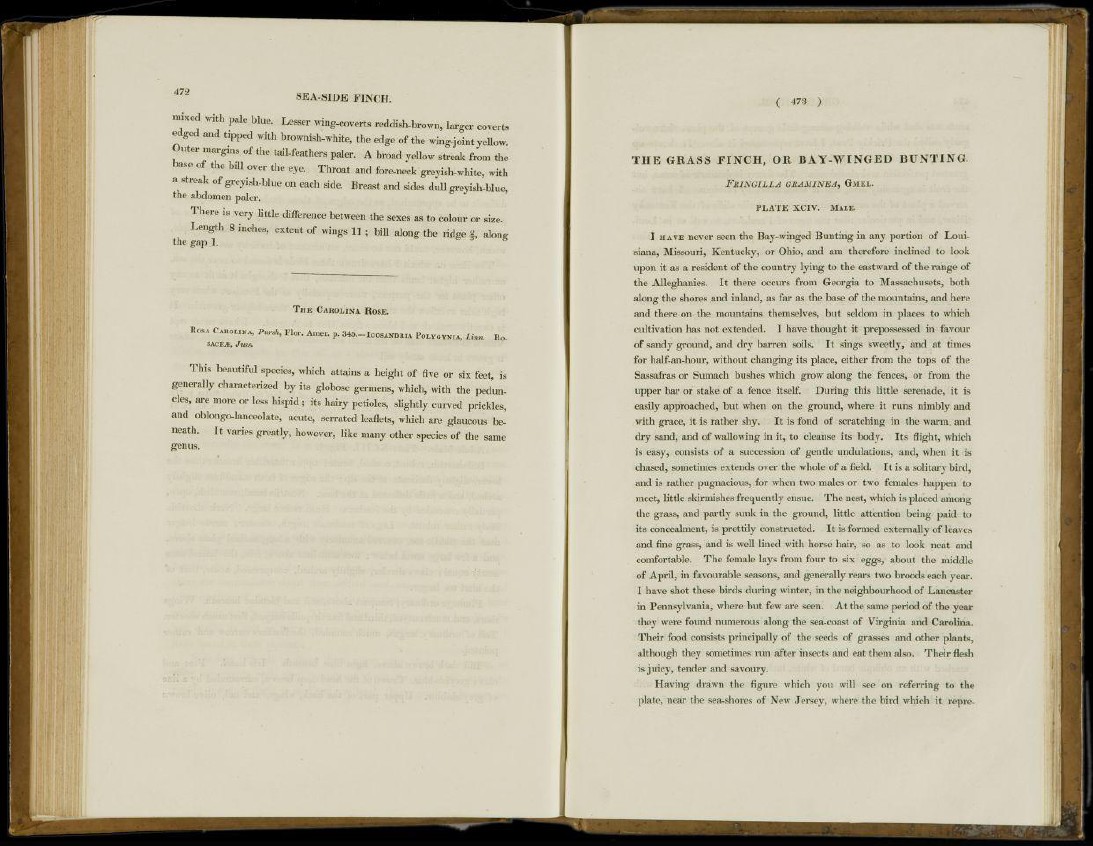
S E A - S I D E FINCH.
mixed with pale blue. Lesser wing-coverts reddish-brown, larger coverts
edged and tipped with brownish-white, the edge of the wing-joint yellow.
Outer margins of the tail-feathers paler. A broad yellow streak from the
base of the bill over the eye. Throat and fore-neck greyish-white, with
a streak of greyish-blue on each side. Breast and sides dull greyish-blue,
the abdomen paler.
There is very little difference between the sexes as to colour or size.
Length 8 inches, extent of wings 1 1 ; bill along the ridge f, along
the gap 1.
THE CAROLINA ROSE.
ROSA CAROLINA, Pursh, Flor. Amer. p. 345.—ICOSANDRIA POLYGYNIA, Linn. Uos
\c , Juss.
This beautiful species, which attains a height of five or six feet, is
generally characterized by its globose germens, which, with the peduncles,
are more or less hispid; its hairy petioles, slightly curved prickles,
and oblongo-lanceolate, acute, serrated leaflets, which are glaucous beneath.
It varies greatly, however, like many other species of the same
genus.
( 473 )
T H E GRASS F I N C H , OR B A Y - W I N G E D BUNTING.
FRINGILLA GRAMÍNEA, GMEL.
P L A T E X C I V . MALE.
I HAVE never seen the Bay-winged Bunting in any portion of Louisiana,
Missouri, Kentucky, or Ohio, and am therefore inclined to look
upon it as a resident of the country lying to the eastward of the range of
the Alleghanies. It there occurs from Georgia to Massachusets, both
along the shores and inland, as far as the base of the mountains, and here
and there on the mountains themselves, but seldom in places to which
cultivation has not extended. I have thought it prepossessed in favour
of sandy ground, and dry barren soils. It sings sweetly, and at times
for half-an-hour, without changing its place, either from the tops of the
Sassafras or Sumach bushes which grow along the fences, or from the
upper bar or stake of a fence itself. During this little serenade, it is
easily approached, but when on the ground, where it runs nimbly and
with grace, it is rather shy. It is fond of scratching in the warm, and
dry sand, and of wallowing in it, to cleanse its body. Its flight, which
is easy, consists of a succession of gentle undulations, and, when it is
chased, sometimes extends over the whole of a field. It is a solitary bird,
and is rather pugnacious, for when two males or two females happen to
meet, little skirmishes frequently ensue. The nest, which is placed among
the grass, and partly sunk in the ground, little attention being paid to
its concealment, is prettily constructed. It is formed externally of leaves
and fine grass, and is well lined with horse hair, so as to look neat and
comfortable. The female lays from four to six eggs, about the middle
of April, in favourable seasons, and generally rears two broods each year.
I have shot these birds during winter, in the neighbourhood of Lancaster
in Pennsylvania, where but few are seen. At the same period of the year
they were found numerous along the sea-coast of Virginia and Carolina.
Their food consists principally of the seeds of grasses and other plants,
although they sometimes run after insects and eat them also. Their flesh
is juicy, tender and savoury.
Having drawn the figure which you will see on referring to the
plate, near the sea-shores of New Jersey, where the bird which it repre